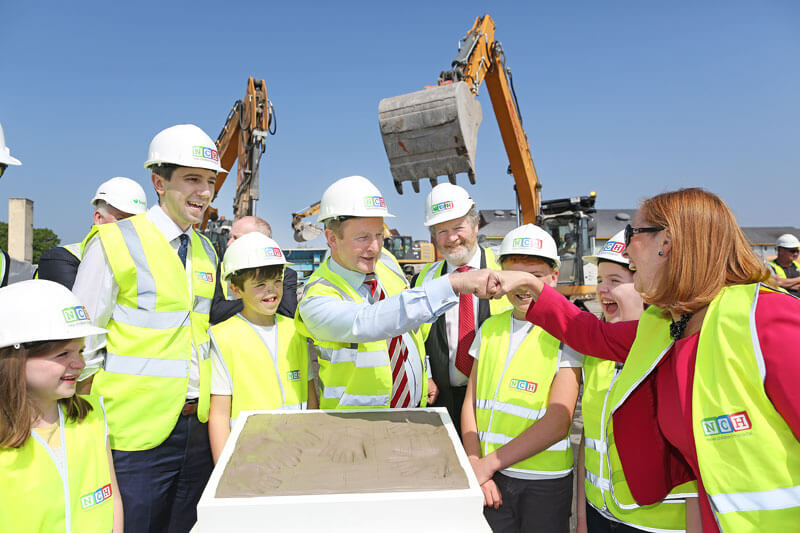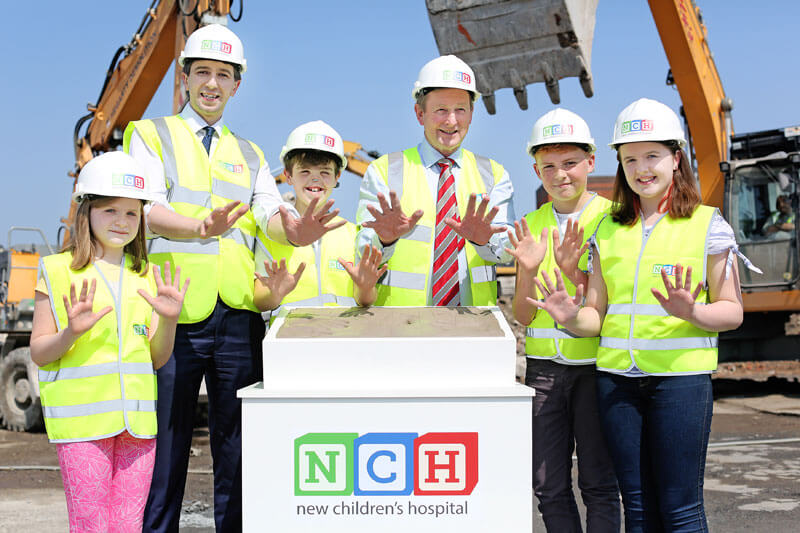The foundation stone for the new children’s hospital was cast last Wednesday by An Taoiseach Enda Kenny, Minister for Health Simon Harris T.D. and members of the Youth Advisory Council.

The children, current and former users of the children’s hospital services, and the Taoiseach embedded their hands into a mould which will be cast in cement and incorporated into the new hospital.
This milestone event follows the recent approval by Government of the investment required to enable the National Paediatric Hospital Development Board to award the construction contracts for the building of the main children’s hospital on the St. James’s Hospital campus and the two Paediatric Outpatients and Urgent Care Centres on the Tallaght and Connolly Hospitals’ campuses. The installation of the foundations is expected within weeks.
The children were representatives of the Youth Advisory Council – a group of young people who are current and former users of the three existing hospitals.
Twelve acres of the St. James’s Hospital Campus is dedicated to the new children’s hospital, it will be the size of Dundrum Town Shopping Centre with an internal street the length of Grafton Street.
Scheduled opening of the hospital and Outpatient and Urgent Care Centres
Clearance and enabling works are complete on the St. James’s Hospital campus, making way for construction to begin on site within the next few weeks.
It is anticipated that the new children’s hospital will open its doors in the third quarter of 2021. The Outpatient and Urgent Care Centres at Connolly Hospital and Tallaght Hospital, which will provide Urgent Care and Outpatient Care to children in the Greater Dublin Area, including Co. Dublin, Wicklow, Meath and Kildare, will open before the main hospital, in late 2018 and the first quarter of 2019.

The buildings have been designed to ensure that children and young people are treated in the best organised and most clinically suitable setting. In the main hospital at St. James’s, there will be 380 single rooms all with en-suite bathrooms and a parent’s bed.
There will be 93 daycare bays, 22 operating theatres and procedure rooms, and 122 consulting rooms in total. The rooftop rainbow garden is a central feature of the design and it will provide a secure and sheltered environment adjacent to the wards. The planned accommodation will include facilities for inpatients, day care patients, outpatients, operating theatres and emergency care.
The hospital will include:
- Outpatients, daycare, theatre, emergency department and critical care units
- Laboratory, medical imaging and diagnostic services
- Specialist therapy and play facilities
- Age-appropriate facilities for children and young people
- Hospital school
- Reception, concourse and public realm including retail spaces in the main atrium
- Operational communication links into the adult hospital and maternity hospital
- Education, training, research and innovation facilities
- Underground car parking
- Inpatient accommodation (all single rooms, en-suite, in-room parent accommodation)
- Three hundred generic inpatient rooms
- Sixty critical care inpatient rooms incorporating paediatric intensive care/high dependency and neonatology intensive care/high dependency
- Twenty child and adolescent mental health beds (incorporating eating disorders and acute Child and Adolescent Mental Health Services (CAMHS))
- Day care facilities
- Sixty one general medical and surgical day care bays
- Four nephrology/urology day care bays
- Twenty two haematology/oncology day care bays
- Six cardiology day care bays
- Operating theatres and procedure rooms
- Twelve general theatres
- Six specialist theatres
- One PIR suite
- Two endoscopy rooms
- One catheterisation laboratory
Outpatients
There will be 110 outpatient consulting/examination rooms at the main hospital
There will be 12 outpatient consulting/examination rooms at the Outpatient and Urgent Care centres (six in each).
Emergency Facilities
ED and urgent care facilities will be provided at the main hospital, with urgent care facilities at the Outpatient and Urgent Care Centres also. There will be 24 short stay observation beds across the hospital and Outpatient and Urgent Care Centres (6 in each Outpatient and Urgent Care centre and 12 in the main hospital), and 56 assessment bays (10 in each Outpatient and Urgent Care centre, and 36 in the main hospital).
Outpatient and Urgent Care Centres at Tallaght and Connolly Hospitals.
The Outpatient and Urgent Care Centres will improve geographic access to urgent care for children in the Greater Dublin Area. Consultant-led urgent care, with 4-6 hour observation beds, appropriate diagnostics and secondary outpatient services including rapid access general paediatric clinics as well as child sexual abuse unit examination, observation and therapy rooms will be provided in the Outpatient and Urgent Care Centres. The centre at Connolly will also include two HSE paediatric care primary care dental services operating theatres.
Children’s Research and Innovation Centre
More than a hospital, the new children’s hospital and Outpatient and Urgent Care Centres will be a research-intensive academic healthcare institution. The main facilities for research and innovation will be located at the Children’s Research and Innovation Centre (CRIC) on the St. James’s campus, which has a rich history in clinical research. The CRIC on the campus will be non-Exchequer funded and will be built using separately raised philanthropic funds.
Integration Programme
The capital project to build the new children’s hospital and Outpatient and Urgent Care Centres will only provide buildings. The overall programme to deliver the new children’s hospital will entail both a complex merger of three different voluntary hospitals and a new build (in addition to a major ICT programme and co-location with an adult and the tri-located maternity hospital). Integration of the three existing paediatric hospitals, the opening of the Outpatient and Urgent Care Centres and the transfer of services to the new hospital facilities while maintaining existing services, patient safety and quality at three existing sites until transition is complete represent a highly complex project in its own right. The major programme of work of clinical integration, people and change management and commissioning required to achieve a successful transition to the new facilities is already underway.

